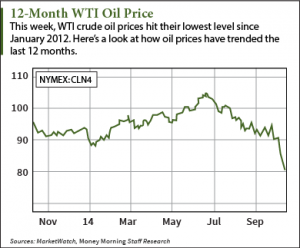Crude oil prices were down sharply again this week, reaching their lowest prices since January 2012.
Thursday, West Texas Intermediate (WTI) crude oil for November delivery dropped to $80.01 a barrel. That's a 23.4% dip from the three-year high it set in June.
 Brent oil prices were down 4.3% to $85.04 Tuesday. That was Brent's biggest one-day drop since September 2011.
Brent oil prices were down 4.3% to $85.04 Tuesday. That was Brent's biggest one-day drop since September 2011.
There are several key factors contributing to oil's drop:
First, global demand has continued to drop since June. This week, the International Energy Agency slashed its full-year oil-demand growth forecast to its lowest total since 2009.
At the same time, U.S. oil output reached 8.7 million barrels per day (bpd) in September, creating a supply glut. That's the United States' highest output total in 30 years.
And it could go even higher. The U.S. Energy Information Administration (EIA) expects that number to jump another 963,000 bpd in 2015, at its current pace.
That's not all. Increased production from Libya, Saudi Arabia, Iraq, Nigeria, and Angola has also boosted the global supply.
But now, a recent development in Saudi Arabia could have the biggest impact of all.
Saudi Arabia's Impact on Oil Prices
Throughout October, many analysts have been expecting Saudi Arabia to cut production in an attempt to raise oil prices. As the world's top oil exporter, Saudi Arabia has a strong influence on the global oil price.
But the Saudis are taking a different approach. One that could create a global oil price war.
According to multiple reports, Saudi officials have decided to let oil prices hover in the $80 range "for a year or two."
Rather than slowing their own production, Saudi Arabia is forcing U.S. oil producers to slow theirs.
"The move by the Saudis suggests that the biggest member of OPEC is prepared to let prices fall rather than cede market share by paring output to clear a supply surplus," said Money Morning's Global Energy Strategist Dr. Kent Moors.
Currently, OPEC nations account for roughly 42% of the world's supply. During a similar supply glut in the 1980s, Saudi Arabia cut production and had a difficult time regaining its market share. The nation doesn't want a repeat.
"There appears to be a direct battle underway among OPEC members for market share in a pricing environment increasingly defined by unconventional (shale and tight) reserves," Moors said.
After the Saudi decision, officials from Kuwait and Iran also said they will not curb output.
"Indications are that the Saudis intend to keep output steady until the end of the year, near the 9.6 million barrels a day extracted in August and September," Moors said. "Refraining from further cuts would preserve the volume of Saudi Arabia's oil sales, curb revenue for competitors, and discourage production of U.S. shale oil."
With the Saudis refusing to budge on production levels, oil prices will remain muted until someone cuts back on production.
And that will impact investors in the three following ways...
Three Things to Expect as Oil Prices Tank
Since June, U.S. oil stocks have been getting crushed.
In the last three months, Exxon Mobil Corp. (NYSE: XOM) is down 11%, Chevron Corp. (NYSE: CVX) has dropped 14.4%, and Hess Corp. (NYSE: HES) has slid 19.7%.
Other U.S. oil drillers like EOG Resources Inc. (Nasdaq: EOG) and Continental Resources Inc. (NYSE: CLR) have fared even worse despite surging production. Those two stocks are down 20.5% and 25.7% respectively.
The smaller U.S. oil drillers like EOG and CLR will continue to be hit hardest by the drop in oil prices. But investors can expect most U.S. oil stock prices to remain low - especially if oil prices continue to hover in the $80 range.
The second thing investors can expect is lackluster performance from oil ETFs - particularly those that track the price of oil.
For instance, the United States Oil Fund (NYSE: USO) tracks changes in the price of light, sweet crude oil based on the futures contracts of the New York Mercantile Exchange. In the last three months, it's down 17.4%.
Likewise, the U.S. Brent Oil Fund (NYSE: BNO) tracks the spot price of Brent futures. It's down 21.4% since mid-July.
Like many oil stocks, these oil ETFs will underperform until the price of oil rebounds.
Third, investors can expect to see a strong performance from natural gas stocks.
"It's another story entirely on the natural gas side," Moors said. "Despite the expanding global reserves of shale, tight gas, and coal bed methane, gas prices are moving up. Once again, more than 80% of extractable reserves worldwide are found outside of North America."
The NYMEX price for natural gas is now above $4 per 1,000 cubic feet (or million BTUs). Moors expects prices to move closer to $4.50 as we move into a winter heating cycle.
That price increase will create numerous profit opportunities for investors heading in 2015.
One of Money Morning's favorite natural gas stocks is Cheniere Energy Partners LP (NYSE: CQP). The liquefied natural gas (LNG) stock sold off a bit in October, but has rebounded 7% in the last four trading sessions. Since the start of 2013, it's up 46.9%.
More from Dr. Kent Moors: Something is now afoot in the Pacific Northwest that will change how we think about pricing oil - and provide a range of fantastic opportunities for investors. Make no mistake: The U.S. oil export surge is coming...
Related Articles:
- Reuters: Worrying for Saudi, U.S. Oil Output Cuts Could Take a While
- Wall Street Journal: Global Oil Glut Sends Prices Plunging


